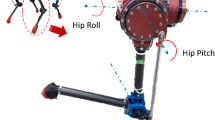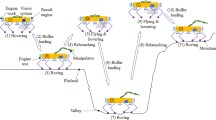Abstract
The purpose of this study is to reduce the impact force when a humanoid robot lands on the ground or the floor. First, the landing postures of a human subject were analyzed while measuring the impact forces when the subject lands on the floor. Through the experimentally observed relations between the landing postures and the impact forces, it was hypothesized that a human being may reduce the impact force by motion control of his or her center of gravity, for example, to lengthen the time of the landing motion. Then, a landing robot was developed, and an experiment to measure the impact forces was conducted to prove the hypothesis.














Similar content being viewed by others
Explore related subjects
Discover the latest articles, news and stories from top researchers in related subjects.References
Shibata M, Natori T (2000) Impact force reduction for biped robot based on decoupling COG control Scheme. In: Proceedings of 6th International Workshop, Advanced Motion Control, 1. pp 612—617
Fujiwara K, kanehiro F, kajita S, Hirukawa H (2004) Safe knee landing of a human-size humanoid robot while falling forward. In: Proceedings of IEEE/RSJ International Conference, Intelligent Robots and Systems, 1. pp 503–508
Kim JH, Oh JH (2004) Walking control of the humanoid platform KHR-1 based on torque feedback control. ICRA’04 IEEE International Conference, Robotics and Automation, 1. pp 623–628
Sato Y, Ohashi E, Ohnishi K (2005) Impact force reduction for hopping robot. 31st Annual Conference of IEEE, Industrial Electronics Society, 1. pp 1821–1826
Kim YD, Lee BJ, Yoo JK, Kim JH, Ryu JH (2006) Compensation for the landing impact force of a humanoid robot by time domain passivity approach. In: Proceedings of IEEE International Conference, Robotics and Automation, 1. pp 1225–1230
Fujiwara K, Kajita S, Harada K, Kaneko K (2006) Towards an optimal falling motion for a humanoid robot. 6th IEEE-RAS International Conference, Humanoid Robots, 1. pp 524–529
Kim YD, Lee BJ, Ryu JH, Kim JH (2007) Landing force control for humanoid robot by time-domain passivity approach. IEEE Transactions of Robotics, 23. pp 1294–1301
Chanthasopeephan T, Jarakorn A, Polchankajorn P, Maneewarn T (2012) Impact reduction mobile robot and the design of the compliant legs. Available at http://www.sciencedirect.com/science
Yu Z, Chen X, Huang Q, Wang H, Zhang S, Xu W, Li J, Ma G, Zhang W, Fan N (2012) Humanoid walking pattern generation based on the ground reaction force features of human walking. International Conference, Information and Automation, 1. pp 753–758
Zhao J, Jing X, Gao B, Xi N, Cintron FJ, Mutka MW, Xiao L (2013) MSU Jumper:a single-motor-actuated miniature steerable jumping robot. IEEE Trans Robotics 29:602–614
Author information
Authors and Affiliations
Corresponding author
About this article
Cite this article
Okamoto, S., Lee, J.H. & Fujieda, H. Computational and experimental analyses on impact reduction when a humanoid robot lands on the ground. Artif Life Robotics 18, 212–218 (2013). https://doi.org/10.1007/s10015-013-0118-9
Received:
Accepted:
Published:
Issue Date:
DOI: https://doi.org/10.1007/s10015-013-0118-9




